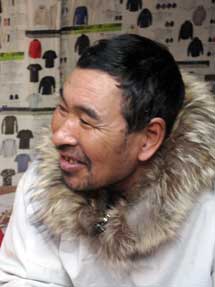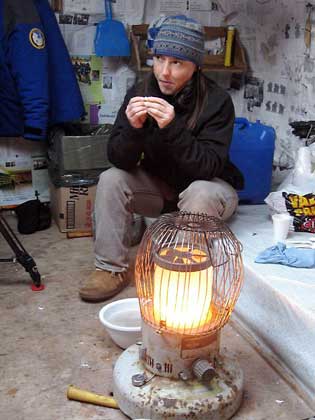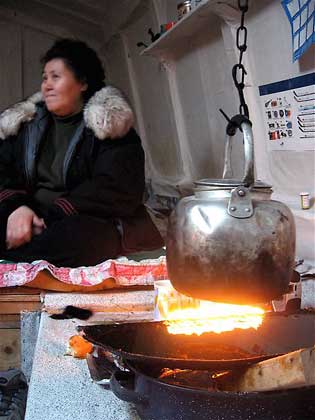
Coordinates: 66.08.795 N, 65.38.324 W
Temperature: -20 °F/ -29 °C
Wind: 5 MPH/ 8 KPH
Cloud Cover: Clear skies becoming partly cloudy
Sunrise: 5:50 a.m.
Sunset: 5:14 p.m.
Jessieloosie Eeshuglutak, an Inuit elder with a warm smile and sparkling eyes, invited Abby and me into a sod house by the ice-covered Pangnirtung shore. Lasaloosie built the sod house with the cooperation of the hamlet and manages it as a traditional skills school and educational center.
From the outside the low house with a rounded roof is almost completely covered in snow. The only clue to the warmth inside is the condensation from the warm air escaping from the roof vent.
Inside, the walls are covered in pages from catalogs and magazines. A propane heater glows quietly in the center of the floor and along the side walls two seal oil lamps, called qulliqs, burn with steady flames. Over one qulliq an aluminum kettle hangs from a chain, heating water for tea. Two women sit on the quilt-covered sleeping platform sewing sealskin mitts.
Abby and I sit on the floor talking with Jessieloosie through Theo as an interpreter. Jessieloosie is wearing sealskin kamiks (boots), sealskin pants, and an anorak with a wolf fur ruff. His sealskin kamiks and pants feature patterns of contrasting dark and light-colored fur.

Coordinates: 66.08.795 N, 65.38.324 W
Temperature: -20 °F/ -29 °C
Wind: 5 MPH/ 8 KPH
Cloud Cover: Clear skies becoming partly cloudy
Sunrise: 5:50 a.m.
Sunset: 5:14 p.m.
Jessieloosie Eeshuglutak, an Inuit elder with a warm smile and sparkling eyes, invited Abby and me into a sod house by the ice-covered Pangnirtung shore. Lasaloosie built the sod house with the cooperation of the hamlet and manages it as a traditional skills school and educational center.
From the outside the low house with a rounded roof is almost completely covered in snow. The only clue to the warmth inside is the condensation from the warm air escaping from the roof vent.
Inside, the walls are covered in pages from catalogs and magazines. A propane heater glows quietly in the center of the floor and along the side walls two seal oil lamps, called qulliqs, burn with steady flames. Over one qulliq an aluminum kettle hangs from a chain, heating water for tea. Two women sit on the quilt-covered sleeping platform sewing sealskin mitts.
Abby and I sit on the floor talking with Jessieloosie through Theo as an interpreter. Jessieloosie is wearing sealskin kamiks (boots), sealskin pants, and an anorak with a wolf fur ruff. His sealskin kamiks and pants feature patterns of contrasting dark and light-colored fur.
 Jessieloosie talks about his youth when he and his family would go by snowmobile and dogteam across the ice of the Cumberland Sound to hunt, fish and visit outpost camps. Now the Cumberland Sound is not frozen at all—it is all open water.
Jessieloosie talks about his youth when he and his family would go by snowmobile and dogteam across the ice of the Cumberland Sound to hunt, fish and visit outpost camps. Now the Cumberland Sound is not frozen at all—it is all open water.
Jessieloosie explains that much of the traditional knowledge does not apply any more. The traditional ways of forecasting the weather are no longer accurate and some of the traditional travel routes are no longer safe. When Jessieloosie teaches the young people, he now must teach both the way it was in the past and the way it is now.
I ask Jessieloosie if he has any advice for those of us who do not have as close a connection to the environment as he has. He says he would like to remind the people in the south that emissions that come out of our smokestacks and burning forests come up to the Arctic. The Arctic climate is warming and the traditional life is changing due to actions of others far away.
After Jessieloosie finishes speaking, we all eat bannock and drink tea. We emerge from the sod house into the bright sunshine and blink to adjust our eyes. We feel fortunate to have glimpsed the traditional ways.
Elizabeth







